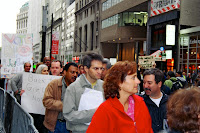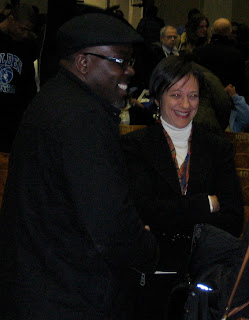
The NY Teacher trumpets every time there is a rare grievance victory. BloomKlein just laugh and refuse to enforce even sustained grievances. Weingarten brags about the pamphlet “Know Your Rights” but when you do stand up for your rights you find the union behind - far behind.
A little over a week ago I got a chilling phone call. It was from a former colleague who taught across the hall from me for a decade. That day (Thurs, Feb. 15) she was arrested and taken from her school in handcuffs based on a bogus charge made by a parent. She was not told the reason or told her rights. Most egregious was the actions of the school administrators. The AP came up to her room and told her she was wanted in the office. Not one other word that there were 5 cops waiting for her to arrest her. 5 cops! I guess there are no other crimes to solve in this city. But I do not blame the police for this.
The former Leadership Academy principal, who is close to the parent, was smiling ear-to-ear. She had finally found a way to remove a teacher who was a thorn in her side (the teacher ran for chapter leader last year and lost by a slim margin.) It was certainly within her power to convince the police that this case did not warrant an arrest.
What kind of monsters do we have running our schools?
How do we know the charge was bogus? While the teacher sat in the police station until 7pm, the police investigated at the school and the child was taken to the hospital by the police and found to not have a mark on her. When they returned to the station, the cop said it was all “nonsense” and they rescinded the arrest. They had looked at her 22-year record and found not one mark against her. “People we spoke to had good things to say about you,” they said. Someone from child support services told the teacher that the parent, who was at the station, said that if the teacher offered an apology, “this would all go away.” “Hell no,” the teacher said. For escorting a child to her seat after she had run out of the room twice? “Hell no!”
The teacher will now spend months or longer in the rubber room. We are efforting to help her find a lawyer to sue everyone involved. Maybe one day she will own the school building where she was so humiliated. And hopefully, the principal’s house.
The principal can keep smiling ear-to-ear, for now, having removed the one person who stood up to her. What a lesson to the rest of the people in the school, which has undergone enormous turnover in just a few years. Ask people if things are not worse than when the principal arrived.
Now, where does the blame lie for this fiasco? The principal? Sure. But I also blame a union leadership that can be so weak, helpless or worse, not consider that this can happen to any teacher in the system at any time, a high priority issue to address.
Why not, you might ask? I should put it in terms of they are more concerned about the bad public relations that might result from a teacher that is guilty than they do about the innocent teachers who have to be put through this. When I told some union officials about the case, they said, “Why didn’t she call the union?” The teacher has no faith in the union and when she did call the district rep the response was not exactly immediate. The UFT will say, “She should have read the “Know Your Rights” pamphlet in their "blame the victim" mentality.
I went to the rubber room at 25 Chapel St. Monday, Feb 26 and videotaped a statement from the teacher as she came out at 3pm. Then we went to the UFT Executive Board meeting where we both spoke. “We have a policy,” was the response. “We get a lawyer to assist you.” What is left out is what they don’t assist you with. The legal assistance is limited. I asked why doesn’t the union take this to the top level of the police department so cops will be alerted that these cases are all too often “nonsense.” The response: “People are guilty too. We’ll get them a lawyer.”
Thus, the UFT has the same response whether the teacher has committed a crime or whether there is a vendetta on the part of a principal or parent or even a child. This attitude is what is undermining the union at the basic level – the school.
There are no repercussions for anyone at the DOE because the teacher is left to fend for herself. If she wants to sue for false arrest, the burden is on her to find and pay for a lawyer. Then if she wins after spending an onerous amount of her won money, the union will trumpet the victory as theirs.
Oh, she might even win her way back into the school from hell after the DOE investigates after months in the rubber room. But what of the image children, parents and colleagues have of her removal in handcuffs?
I can point to case after case where Randi Weingarten has protected principals and superintendents, not wanting to interfere with cozy political arrangements.
When Jeff Kaufman, one of the ICE HS reps on the current Exec Bd and himself a former lawyer made a resolution last June calling on the UFT to provide more support to teachers in this position by hiring paralegals to do their own investigation apart from the DOE—questioning witnesses, etc, Weingarten and the Exec Bd were opposed. After all, they have to use the money for more insipid commercials. This is one of the reasons why Weingarten is so anxious to get Kaufman and other ICE-TJC reps off the Board.
At the Feb. 26 Exec. Bd meeting, Jeff and others in ICE gave the teacher a sense of support she does not get from the UFT. Jeff told her what she would have to do and gave her a lot of advice. At the end of the meeting, long-time Unity hack Sandra March, one of our 3 pension reps, attacked me, typical of the standard Unity response.
Because ICE raised this case to such a high profile, we expect the UFT to respond with a higher level of attention than the average teacher would get.
If ICE-TJC had more influence, we would call a press conference in front of the school and parade the teacher as the poster girl for teacher abuse. We would help her find a lawyer and make the DOE pay to such an extent they will think very long and hard before letting this happen to another teacher.
There would be consequences for allowing this to happen to an innocent teacher. The law will take care of the guilty. The UFT should stand up and deliver for the innocents.

























